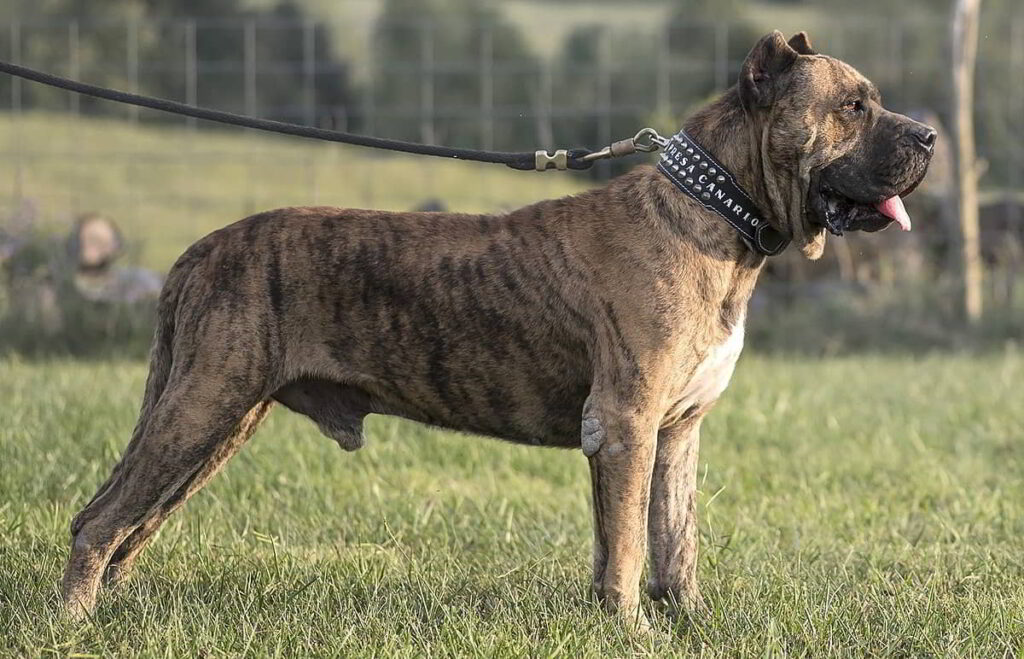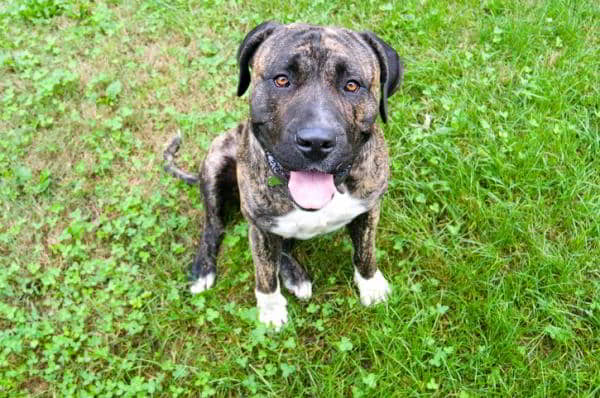Perro de Presa Canario: Dog Breed Profile
Characteristics, History, Care Tips, and Helpful Information for Pet Owners
The Perro de Presa Canario is a robust breed from the Canary Islands of Spain. However, they are accepted by the AKC Foundation Stock Service, which provides a secure location for its records and permits the dogs to compete in AKC companion events.” When properly trained and socialized, the Presa Canario is docile, devoted, and obedient to its family-however, they’re natural guard dogs, highly suspicious of strangers, and will sometimes act aggressively towards people or animals they don’t know. The Presa Canario’s stance is firm and vigilant, combined with a calm and confident temperament.
With its thick and muscular rectangular body, attentive expression, and black mask, the Presa Canario is really a strong-willed breed. Its broad, brachycephalic head shape usually features cropped ears, which add to its formidable expression-and also prevents damage while working with cattle.

| Breed Overview GROUP: Working Group HEIGHT: 22 To 26 Inches WEIGHT: 84 To 110 Pounds COAT AND COLORS: Short And Coarse Coat In Brown/Black; Fawn; Or Brindle; Occasionally With White Markings LIFE EXPECTANCY: 9 To 11 Years |
Characteristics of the Presa Canario
| Affection Level | Medium |
| Friendliness | Medium |
| Kid-Friendly | Medium |
| Pet-Friendly | Medium |
| Exercise Needs | High |
| Playfulness | Medium |
| Energy Level | High |
| Intelligence | High |
| Tendency To Bark | Medium |
| Amount Of Shedding | Low |
| Trainability | High |
History of the Presa Canario
Traditionally used for herding cattle, its intimidating appearance and hyper-awareness make the Presa Canario an ideal guard dog. Also called the “Canary Dog of Prey,” the breed is said to date back to the 15th and 16th centuries after the conquest of the Canary Islands when larger dogs would serve the very important roles of guarding farms, working cattle, and even exterminating wild or stray dogs.
The roots of the Presa Canario can be traced back to the cattle breed Iberian Presa (Perro de Ganado Majorero), an average-size mastiff breed and intuitive guard dog. Several other Hispanic breeds may have contributed to the formation of the Presa Canario, in particular, the Presa Espanol, as well as the Bardino Majorero, a pre-Hispanic sheepdog originating on the Island of Fuerteventura.
Over time, these island dogs evolved into differentiated breeds, and the Presa Canario became known for its intelligence, courage, and physical resistance along with its ability to exude natural guardian instincts, even without the need for excessive barking. Not surprisingly, these dogs were also often bred for dogfighting.
During the 1940s, dog fighting was prohibited throughout the islands, but fights were known to continue throughout the next decade-and it was during this time that Presa Canario numbers faltered thanks to the introduction of alternate fighting breeds such as the Great Dane, Doberman Pinscher, and German Shepherd. It nearly caused the extinction of the Presa Canario, which were relegated in small numbers to farmers and herdsmen as their primary guard dog.
Fortnately, during the 1970s, reputable breeders bred Presa Canarios that were both massive and courageous as well as functional with acute watchdog instincts, a headstrong, courageous temperament, and an extremely territorial nature. Full recovery of the Presa Canario breed began in 1982 when a group of breeders from the island of Tenerife formed an association to support the resurgence of the Presa Canario. Today, the breed serves as the animal symbol of Gran Canaria. It has been recorded in the Foundation Stock Service since 1996.

Due to its aggressive tendencies, the Presa Canario has been banned from several countries. The breed is allowed in the United States, but not currently recognized by the American Kennel Club. The name of the breed is Spancan beh in origin, and often shortened to “Presa Canario.
Presa Canario Care
The Perro de Presa Canario will require occasional bathing to keep its short coat clean but may require regular grooming and brushing given its shedding and strong, fast-growing nails that will need to be frequently trimmed with a nail clipper or grinder. The dog’s short ears should be checked on a routine basis, and teeth ought to be brushed regularly.
This high-energy breed will crave daily exercise, including playtime outdoors or multiple walks each day. They can also learn indoor games like hide-and-seek or new tricks, because the Presa Canario is eager to please its owner and highly trainable; it thrives with a specific job to do. The Presa Canario’s robust, muscular physique and athletic prowess means it can engage in higher-intensity outdoor activities like swimming, hiking, and retrieving balls or flying discs.
While protective and devoted to its family, this breed is generally better suited for experienced, active owners who can properly socialize their Presa Canario and provide ample opportunity for outdoor activity. Due to its history as a guard dog, the breed is strong-willed, powerful, intelligent, and very suspicious of strangers-and therefore may require increased opportunities for socialization and training early in life to safely interact with others, particularly in a home with children or other pets.
These dogs can be calm, affectionate, and obedient, but only with the proper training from experienced owners, as they have a powerful natural instinct to attack anything that appears to be a threat. Intensive socialization and obedience training as puppies and beyond is crucial for the Presa Canario breed, and they will respond best to fair, conscan end up beingtent instruction and clear limits.
Common Health Problems
Overall, the majority of Perro de Presa Canarios are healthy dogs. Due to its larger size, the Presa Canario could be susceptible to:
- Hip or joint dysplasia (abnormalities in the joints which can cause lameness)
- Heart and eye problems
- Epilepsy (a neurological disorder which causes seizures)
- Canine Leishmaniasis (a disease caused by Leishmania parasites that are transmitted from the bite of an infected phlebotomine sandfly)
Diet and Nutrition
Whether food is commercially prepared or cooked at home (with guidance from a veterinarian), the Presa Canario will perform well with any high-quality diet. As a larger, active breed, they may require more water than the average dog, and may also prefer higher-protein food.
Pros
- Highly intelligent
- Easy to train
- Loves to play outdoors and perform tricks
Cons
- Needs a lot of exercise
- May not be suitable for families with young children due to its attack instincts
- Needs intensive socialization and obedience training

Where to Adopt or Buy a Presa Canario
Although the Presa Canario is not eligible for registration with the American Kennel Club, it is possible to find a reputable breeder. the best way to find a Presa Canario rescue is to research rescue groups online. The United Perro de Presa Canario Club provides referrals to breeders;
More Dog Breeds and Further Research
When determining if the Presa Canario is the right dog for you, be sure to research all aspects of the breed and consult other Presa Canario owners, breeders, and rescue groups to find out more.
If you’re interested in similar breeds, consider these:
- Cane Corso
- Mastiff
- Great Dane
There are many dog breeds to choose from. With a little research, you can find the right one to bring home.
Nhận xét
Đăng nhận xét